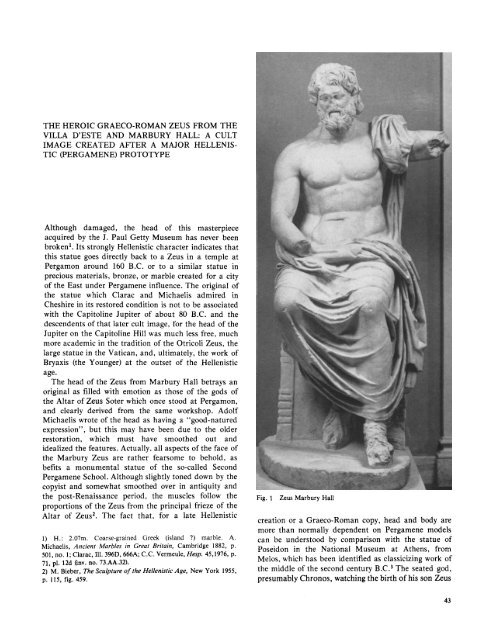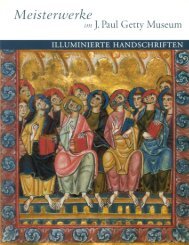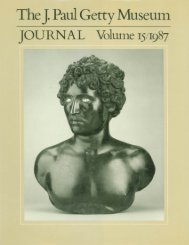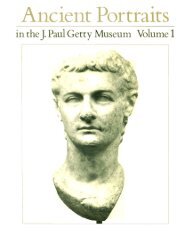The J. Paul Getty Museum Journal Volume 5 1977
The J. Paul Getty Museum Journal Volume 5 1977
The J. Paul Getty Museum Journal Volume 5 1977
Create successful ePaper yourself
Turn your PDF publications into a flip-book with our unique Google optimized e-Paper software.
THE HEROIC GRAECO-ROMAN ZEUS FROM THE<br />
VILLA D'ESTE AND MARBURY HALL: A CULT<br />
IMAGE CREATED AFTER A MAJOR HELLENIS-<br />
TIC (PERGAMENE) PROTOTYPE<br />
Although damaged, the head of this masterpiece<br />
acquired by the J. <strong>Paul</strong> <strong>Getty</strong> <strong>Museum</strong> has never been<br />
broken 1 . Its strongly Hellenistic character indicates that<br />
this statue goes directly back to a Zeus in a temple at<br />
Pergamon around 160 B.C. or to a similar statue in<br />
precious materials, bronze, or marble created for a city<br />
of the East under Pergamene influence. <strong>The</strong> original of<br />
the statue which Clarac and Michaelis admired in<br />
Cheshire in its restored condition is not to be associated<br />
with the Capitoline Jupiter of about 80 B.C. and the<br />
descendents of that later cult image, for the head of the<br />
Jupiter on the Capitoline Hill was much less free, much<br />
more academic in the tradition of the Otricoli Zeus, the<br />
large statue in the Vatican, and, ultimately, the work of<br />
Bryaxis (the Younger) at the outset of the Hellenistic<br />
age.<br />
<strong>The</strong> head of the Zeus from Marbury Hall betrays an<br />
original as filled with emotion as those of the gods of<br />
the Altar of Zeus Soter which once stood at Pergamon,<br />
and clearly derived from the same workshop. Adolf<br />
Michaelis wrote of the head as having a "good-natured<br />
expression", but this may have been due to the older<br />
restoration, which must have smoothed out and<br />
idealized the features. Actually, all aspects of the face of<br />
the Marbury Zeus are rather fearsome to behold, as<br />
befits a monumental statue of the so-called Second<br />
Pergamene School. Although slightly toned down by the<br />
copyist and somewhat smoothed over in antiquity and<br />
the post-Renaissance period, the muscles follow the<br />
proportions of the Zeus from the principal frieze of the<br />
Altar of Zeus 2 . <strong>The</strong> fact that, for a late Hellenistic<br />
1) H.: 2.07m. Coarse-grained Greek (island ) marble. A.<br />
Michaelis, Ancient Marbles in Great Britain, Cambridge 1882, p.<br />
501, no. 1; Clarac, 111. 396D, 666A; C.C. Vermeule, Hesp. 45,1976, p.<br />
71, pi. 12d (inv. no. 73.AA.32).<br />
2) M. Bieber, <strong>The</strong> Sculpture of the Hellenistic Age, New York 1955,<br />
p. 115, fig. 459.<br />
Fig. 1 Zeus Marbury Hall<br />
creation or a Graeco-Roman copy, head and body are<br />
more than normally dependent on Pergamene models<br />
can be understood by comparison with the statue of<br />
Poseidon in the National <strong>Museum</strong> at Athens, from<br />
Melos, which has been identified as classicizing work of<br />
the middle of the second century B.C. 3 <strong>The</strong> seated god,<br />
presumably Chronos, watching the birth of his son Zeus<br />
43








